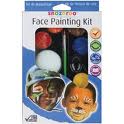Green Halloween
While most people have been brainstorming costume ideas, we’ve been brainstorming ways to make this year’s Halloween a greener holiday! You’ll be happy to know these tips won’t affect your favorite tricks or treats.

Our post about Halloween from last year told us the scary truths of toxic chemicals found in our favorite costumes, decorations, and treats. Check it out to learn more about chemical exposure during this eerie holiday season.
Here are some other tips for an more environmentally-friendly holiday:
1. Re-use costumes
Trade with friends, look in thrift stores, or tear apart your closet for old clothes or fabric. Find accessories at yard sales. Don’t forget to avoid plastic masks and makeup containing harmful toxic chemicals, especially face paint. When Halloween is over, make sure you save your costume for next year, or trade it to someone who might find a good use for it.
2. Find a unique and reusable trick-or-treat bag
Get creative with this aspect of your costume and re-use a bag. Kids will love to create their own personal trick-or-treat bag by decorating a blank canvas bag or old pillowcase with non-toxic paint or non-toxic markers.
3. Serve healthier treats.
If your family chooses to opt-out of sugary candy, think out of the box for other treats kids enjoy. Here are a few ideas:
- Stickers
- Yarn bracelets
- Seashells
- Acorns
- Seed packets
- Home-made barrettes or hair clips
- Coins
- Pencils made from recycled material
- Polished rocks
- Small pumpkins
4. Support local farmers by eating and decorating locally
Shop for foods in-season, and stick to organic and pesticide-free options. Purchase natural decorations such as pumpkins, gourds, haystacks, and corn husks. If you’re hosting a party, use big bowls of snacks to serve guests rather than individually packaged treat bags. Plastic food containers and candy wrappers quickly add up this time of year, and taking small steps to cut down on your own packaging makes a huge difference in plastic trash accumulation.
5. Spread the word and inspire others to use Greener Halloween ideas this season!

 shouldn’t be inhaled! As that is pretty much impossible to avoid, opt for a wig instead.
shouldn’t be inhaled! As that is pretty much impossible to avoid, opt for a wig instead.